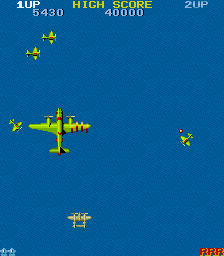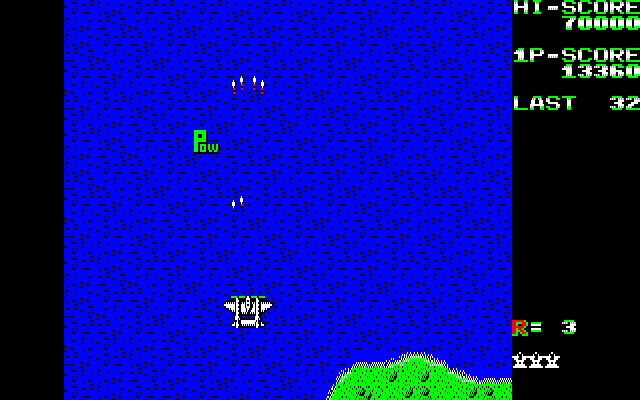Retro Replay Review
Gameplay
1942 delivers classic vertically scrolling shooter action that remains as addictive today as it was when first released in arcades. Players take on the role of “Super Ace,” piloting a nimble fighter plane through 24 increasingly challenging stages. Each level begins and ends on your aircraft carrier, giving a brief sense of progression before you’re sent hurtling into enemy territory filled with waves of hostile fighters, bombers, and naval vessels.
(HEY YOU!! We hope you enjoy! We try not to run ads. So basically, this is a very expensive hobby running this site. Please consider joining us for updates, forums, and more. Network w/ us to make some cash or friends while retro gaming, and you can win some free retro games for posting. Okay, carry on 👍)
The controls are simple yet satisfyingly responsive: move in eight directions, fire continuously, and use a limited “roll” maneuver up to three times per life to evade dense enemy fire. Mastering the timing of these rolls is crucial, as chaining them into your attack patterns can mean the difference between clearing a swarm of enemies for power-ups or meeting an untimely demise.
Power-ups drop from special enemy formations, boosting your firepower from single shots to rapid double or triple barrages. This upgrades mechanic encourages aggressive play—risk flying through the thick of bombs to snag an icon and watch your offensive capabilities soar. Between two-player co-op and solo runs, 1942’s gameplay loop is relentless, challenging players to memorize enemy patterns, manage their limited evasive rolls, and push further through all 24 stages, from Midway to the final showdown in The Final Area.
Graphics
Though born in the golden age of arcade gaming, 1942’s visual style holds a nostalgic charm that modern shooters sometimes lack. Sprites are crisply defined, with clear silhouettes for enemy planes, bullets, and power-up icons. The blue expanse of ocean beneath your aircraft transforms subtly into island chains and burning battlefields, giving each level a distinct atmosphere.
Enemy formations are color-coded and easy to read, which is essential in the heat of combat. Explosions flash with bright oranges and reds, standing out against the sky and sea backgrounds to give players immediate feedback on successful hits. The seamless vertical scroll keeps the action flowing smoothly, ensuring no jarring frame drops as waves of foes descend.
While there’s no 3D polygonal magic or dynamic lighting, 1942’s art direction excels through clarity and purpose. Every visual element was designed to serve gameplay: you instantly recognize a power-up icon, gauge your roll’s remaining uses, and anticipate incoming formations. This simplicity in design remains a high point, making the graphics both functional and endearing to fans of vintage shooters.
Story
Story in 1942 is kept delightfully straightforward: you are the Allied pilot “Super Ace,” tasked with breaking the back of enemy air forces in the midst of World War II’s Pacific Theater. The narrative unfolds implicitly through stage names and background changes—each level title such as “Midway” or “Coral Sea” grounds the action in real historic battles, lending an aura of authenticity to your mission.
The minimalist approach to storytelling is a hallmark of early arcade titles, focusing players’ attention squarely on the action. Between stages, you return to your aircraft carrier, briefly suggesting respite and progress in your campaign before diving back into the fray. This cyclical design reinforces the thematic stakes: each sortie is a small piece of a larger war effort, and every cleared level feels like a hard-won victory.
For those seeking deeper narrative immersion, the simplicity might feel lacking, but it also grants the game timeless appeal. Without cutscenes or lengthy dialogues, 1942 lets your skill write the story—each success, near-miss, and high-score run becomes part of your personal legend as the Super Ace who battled through 24 intense stages of aerial combat.
Overall Experience
Playing 1942 today is like opening a time capsule: the core design is as pure and compelling as any modern indie shoot ’em up. The difficulty curve is steep but fair, rewarding pattern recognition and precise use of rolls and power-ups. Each run is a test of endurance, hand-eye coordination, and strategic risk-taking, especially when aiming to conserve rolls for boss encounters or tight bullet clusters.
Cooperative play adds another layer of enjoyment. Partnering with a friend doubles the onscreen chaos but also the satisfaction of executing coordinated attacks. Watching your comrade bag a rare power-up or dodge a near-fatal attack with a timely roll creates memorable moments that transcend the simple arcade formula.
Overall, 1942 remains a shining example of arcade shooter design. Its concise mechanics, clear visuals, and relentless challenge come together in an experience that’s easy to pick up yet hard to master. For fans of retro gaming or newcomers curious about the genre’s roots, 1942 offers a brisk, engaging journey through World War II–inspired skies that still holds up remarkably well after decades.
 Retro Replay Retro Replay gaming reviews, news, emulation, geek stuff and more!
Retro Replay Retro Replay gaming reviews, news, emulation, geek stuff and more!









Reviews
There are no reviews yet.